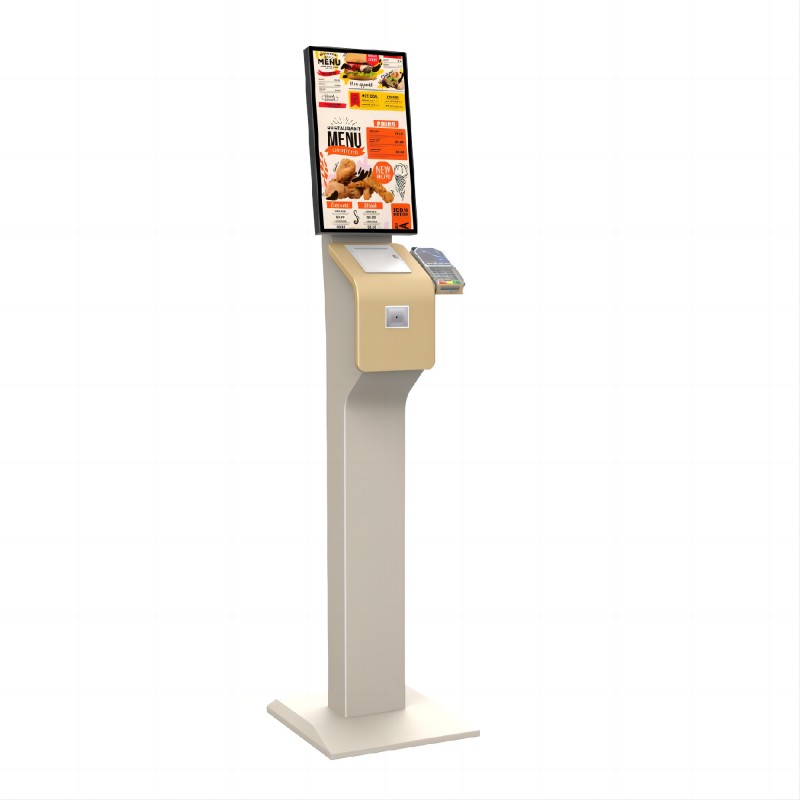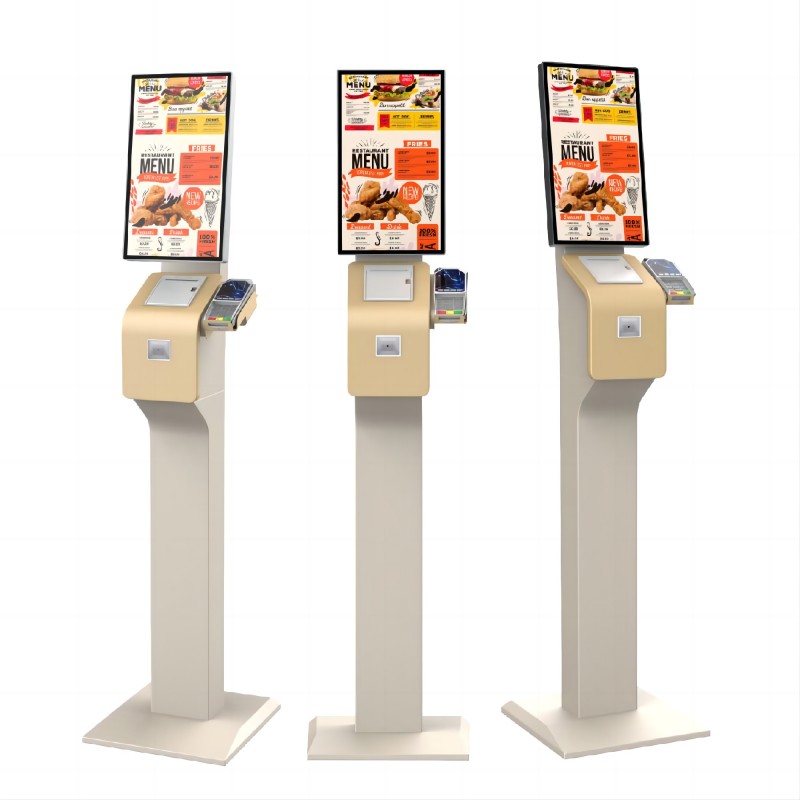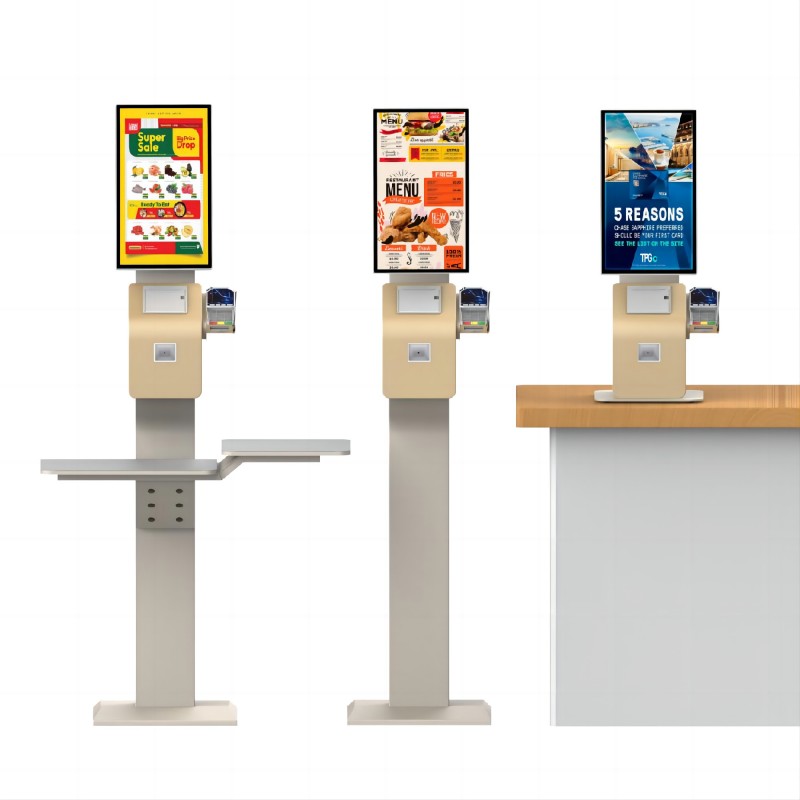
Below is a kiosk stand video, please watch carefully for more details
From the video above, you can see our kiosk stand has exquisite design, high performance and stable working performance, and smooth user operation experience. You deserve it.
| Component | Description | Component | Description |
|---|---|---|---|
| Base | The foundational support that ensures stability. | Pole/Column | The vertical part that holds the display at a suitable height. |
| Mounting Plate | The platform or bracket where the kiosk is attached. | Adjustment Mechanism | Allows for height or angle adjustments to optimize user accessibility. |
| Enclosure/Casing | Covers and protects internal components and wiring. | Cable Management | Organizes and conceals cables for a neat and professional appearance. |
| Footing/Legs | Provides balance and prevents tipping; can be adjustable. | Security Features | Includes locks or other mechanisms to secure the kiosk. |
Retail Stores: Displays interactive kiosks for self-service checkouts, product information, and promotions.
Hospitals: Supports patient check-in kiosks and information displays in lobbies and waiting areas.
Airports: Holds ticketing and check-in kiosks for passenger convenience and self-service.
Public Libraries: Provides stands for self-checkout kiosks and catalog lookup stations.
Museums: Displays interactive exhibits and information kiosks for visitor engagement.
Event Venues: Used for ticketing, event schedules, and interactive maps at entrance points.
Government Buildings: Supports kiosks for public service information, document submissions, and self-service applications.
Restaurants: Holds self-ordering kiosks for customers to place and pay for orders efficiently.

Design and Planning: Define the specifications, including size, materials, and customization needs. Create detailed design blueprints.
Material Selection: Choose appropriate materials (e.g., metal, wood, acrylic) based on durability, aesthetics, and functionality requirements.
Fabrication: Cut, shape, and assemble the chosen materials. This involves welding, machining, and assembling various components like poles, bases, and mounting plates.
Finishing: Apply finishes such as powder coating, painting, or laminating to enhance appearance and durability. Ensure the surface is smooth and free of defects.
Assembly: Combine all components, including the base, pole, mounting plate, and any additional features like cable management or security locks. Ensure all parts fit together securely.
Quality Control: Inspect the assembled kiosk stand for defects or issues. Test for stability, adjustability, and overall functionality to meet design specifications.
Installation: Deliver and install the kiosk stand at the intended location. Ensure it is properly anchored and adjusted for optimal performance and user accessibility.
Final Testing: Perform final checks to ensure the kiosk stand supports the intended kiosk display securely and functions as expected. Make any necessary adjustments or corrections.

Design and Aesthetics: Customizable shapes, colors, and finishes to match branding or interior decor.
Height and Size: Adjustable or custom heights and sizes to accommodate different kiosk displays and user needs.
Material Choices: Selection of materials such as metal, wood, acrylic, or composites for durability and style.
Mounting and Positioning: Options for fixed, adjustable, or swiveling mounts to ensure optimal viewing angles and user accessibility.
Cable Management: Integrated systems to organize and conceal cables, enhancing the stand’s appearance and safety.
Security Features: Custom locks, tamper-proof designs, or reinforced structures to secure the kiosk and its components.
Additional Features: Inclusion of features like shelving, storage compartments, or signage holders for added functionality and convenience.

Purpose and Functionality: Define the specific use of the kiosk stand, such as for interactive displays, information stations, or point-of-sale systems.
Design and Customization: Ensure the design aligns with your brand and space requirements, considering customization options like materials, colors, and dimensions.
Material and Build Quality: Choose durable materials that can support the weight of the kiosk and withstand frequent use.
Compatibility: Verify that the stand is compatible with the specific kiosk model and size you plan to use.
Adjustability: Consider features like adjustable height or angle to accommodate different user needs and settings.
Security Features: Ensure the stand includes features to secure the kiosk and deter tampering or theft.
Budget: Set a budget that includes the cost of the stand, customization, and any additional features or accessories.
Vendor Reputation and Support: Select a reliable vendor with positive reviews and strong support services for installation and maintenance.
Identify Requirements: Determine the kiosk stand’s purpose, desired features, and any customization needs.
Research Vendors: Look for reputable suppliers or manufacturers that offer the type of stand you need.
Compare Options: Review different models, materials, and customization options from various vendors.
Request Quotes: Obtain quotes from selected vendors to compare prices, customization options, and additional costs.
Review Proposals: Evaluate the proposals based on quality, design, cost, and support services.
Place Order: Choose the vendor that best meets your needs and place an order, including any customization details.
Arrange Delivery and Installation: Coordinate delivery and installation with the vendor, ensuring the stand is set up correctly and securely.
Inspect and Test: After installation, inspect the stand to ensure it meets specifications and test it with the kiosk to confirm compatibility and stability.
What did our happy clients say?
The kiosk stand exceeded our expectations! Its sleek design and sturdy build fit perfectly in our space, and the customization options were spot-on. Very satisfied with the quality!
We’re thrilled with our new kiosk stand. It’s solid, easy to assemble, and the adjustable height feature is just what we needed. Great value for the investment and superb customer service!
The kiosk stand we purchased is fantastic! It matches our branding perfectly and provides excellent stability for our kiosk. The cable management system keeps everything neat and organized.
Extremely happy with the kiosk stand. It was delivered on time, set up easily, and looks professional in our store. The custom options allowed us to get exactly what we wanted.